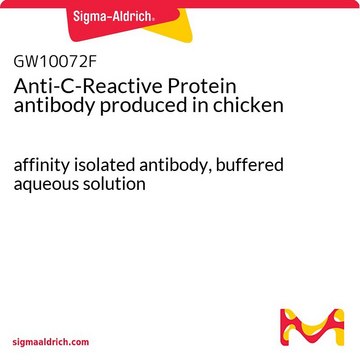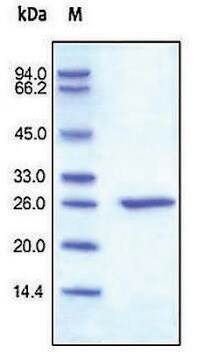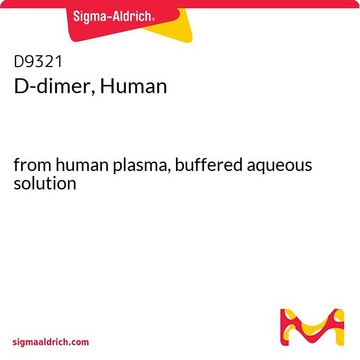Wszystkie zdjęcia(1)
Kluczowe dokumenty
C8284
Anti-C-Reactive Protein antibody produced in goat
whole antiserum
Synonim(y):
Anti-CRP
Zaloguj sięWyświetlanie cen organizacyjnych i kontraktowych
About This Item
Polecane produkty
pochodzenie biologiczne
goat
Poziom jakości
białko sprzężone
unconjugated
forma przeciwciała
whole antiserum
rodzaj przeciwciała
primary antibodies
klon
polyclonal
zawiera
15 mM sodium azide
reaktywność gatunkowa
human
metody
Ouchterlony double diffusion: 1:16-1:32
numer dostępu UniProt
Warunki transportu
dry ice
temp. przechowywania
−20°C
docelowa modyfikacja potranslacyjna
unmodified
informacje o genach
human ... CRP(1401)
Opis ogólny
C-reactive protein (CRP) is a first acute-phase plasma protein. It is synthesized in the hepatocyte and the concentration increase during inflammatory states even chronic inflammation. It′s level can increase during inflammation by up to 100 or 500 times.
C-reactive protein is encoded by the gene mapped to human chromosome 1q23.2.
Specyficzność
Specificity for human CRP is determined by immunoelectrophoresis (IEP) versus human CRP positive serum and purified human CRP. No reactivity with normal human serum is observed.
Zastosowanie
Anti-C-Reactive Protein antibody produced in goat has been used in enzyme-linked immunosorbent assay (ELISA). It has also been used in immunoassay reproducibility and binding affinity investigation of CRP-anti-CRP interaction.
Anti-C-Reactive protein antibody has been used in:
- immunoassay reproducibility and binding affinity investigation of CRP-anti-CRP interaction.
- in-house ELISA assay to study the CRP levels in plasma sample.
Applications in which this antibody has been used successfully, and the associated peer-reviewed papers, are given below.
Enzyme-linked immunosorbent assay (1 paper)
Enzyme-linked immunosorbent assay (1 paper)
Działania biochem./fizjol.
C-reactive protein (CRP) plays an important role to provide an enhanced clearance of inappropriate materials from the plasma, whether these are of extrinsic origin, such as microorganisms and their products or the autologous products of cell damage and death. It acts as a systemic biomarker of acute inflammation and tissue damage.
Postać fizyczna
Goat Anti-Human CRP is supplied as a liquid containing 0.1% sodium azide (see MSDS) as preservative.
Przechowywanie i stabilność
For continuous use, store at 2-8 °C for up to one month. For extended storage, the solution may be frozen in working aliquots. Repeated freezing and thawing is not recommended. Storage in "frost-free" freezers not recommended. If slight turbidity occurs upon prolonged storage, clarify the solution by centrifugation before use.
Oświadczenie o zrzeczeniu się odpowiedzialności
Unless otherwise stated in our catalog or other company documentation accompanying the product(s), our products are intended for research use only and are not to be used for any other purpose, which includes but is not limited to, unauthorized commercial uses, in vitro diagnostic uses, ex vivo or in vivo therapeutic uses or any type of consumption or application to humans or animals.
Ta strona może zawierać tekst przetłumaczony maszynowo.
Nie możesz znaleźć właściwego produktu?
Wypróbuj nasz Narzędzie selektora produktów.
Kod klasy składowania
10 - Combustible liquids
Klasa zagrożenia wodnego (WGK)
nwg
Temperatura zapłonu (°F)
Not applicable
Temperatura zapłonu (°C)
Not applicable
Wybierz jedną z najnowszych wersji:
Masz już ten produkt?
Dokumenty związane z niedawno zakupionymi produktami zostały zamieszczone w Bibliotece dokumentów.
Klienci oglądali również te produkty
Yu-Jui Fan et al.
Langmuir : the ACS journal of surfaces and colloids, 26(17), 13751-13754 (2010-08-03)
A new technique is developed to measure the nanoparticles' brownian motions by employing microparticle-tracking velocimetry (micro-PTV) in evanescent wave field, which can provide high signal-to-noise ratio images for analyzing nanoparticles' movements. This method enables real-time detection of C-reactive proteins (CRPs)
Intestinal parasites coinfection does not alter plasma cytokines profile elicited in acute malaria in subjects from endemic area of Brazil
Sanchez-AJC, et al.
Mediators of Inflammation (2014)
J Hurlimann et al.
The Journal of experimental medicine, 123(2), 365-378 (1966-02-01)
The site of formation of C-reactive protein (CxRP, CRP) has been studied with tissues from rabbits, monkeys, and human beings. Rabbits and monkeys were stimulated to produce the acute phase protein by injection of turpentine, croton oil, endotoxin, paratyphoid-typhoid vaccine
Josué da Costa Lima-Junior et al.
Memorias do Instituto Oswaldo Cruz, 107(8), 1035-1041 (2013-01-09)
The haematological changes and release of soluble mediators, particularly C-reactive protein (CRP) and nitric oxide (NO), during uncomplicated malaria have not been well studied, especially in Brazilian areas in which the disease is endemic. Therefore, the present study examined these
M B Pepys et al.
Advances in immunology, 34, 141-212 (1983-01-01)
The acute phase response among plasma proteins is a normal response to tissue injury and is therefore a fundamental aspect of many diverse disease processes. It probably usually has a beneficial net function in limiting damage and promoting repair but
Nasz zespół naukowców ma doświadczenie we wszystkich obszarach badań, w tym w naukach przyrodniczych, materiałoznawstwie, syntezie chemicznej, chromatografii, analityce i wielu innych dziedzinach.
Skontaktuj się z zespołem ds. pomocy technicznej









